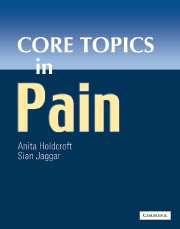Book contents
- Frontmatter
- Contents
- Contributors
- Preface
- Acknowledgements
- Foreword
- General abbreviations
- Basic science abbreviations
- PART 1 BASIC SCIENCE
- PART 2 PAIN ASSESSMENT
- Section 2a Pain measurement
- Section 2b Diagnostic strategies
- PART 3 PAIN IN THE CLINICAL SETTING
- Section 3a Clinical presentations
- Section 3b Pain syndromes
- 19 Myofascial/musculoskeletal pain
- 20 Neuropathic pain
- 21 Visceral nociception and pain
- 22 The management of low back pain
- 23 Cancer pain
- 24 Post-operative pain
- 25 Complex regional pain syndrome
- 26 Uncommon pain syndromes
- 27 Pain in children
- 28 Pain in the elderly
- 29 Gender and pain
- PART 4 THE ROLE OF EVIDENCE IN PAIN MANAGEMENT
- PART 5 TREATMENT OF PAIN
- Section 5a General Principles
- Section 5b Physical treatments
- Section 5c Pharmacology
- Section 5d Psychosocial
- PART 6 SUMMARIES
- Glossary
- Index
26 - Uncommon pain syndromes
from Section 3b - Pain syndromes
Published online by Cambridge University Press: 10 December 2009
- Frontmatter
- Contents
- Contributors
- Preface
- Acknowledgements
- Foreword
- General abbreviations
- Basic science abbreviations
- PART 1 BASIC SCIENCE
- PART 2 PAIN ASSESSMENT
- Section 2a Pain measurement
- Section 2b Diagnostic strategies
- PART 3 PAIN IN THE CLINICAL SETTING
- Section 3a Clinical presentations
- Section 3b Pain syndromes
- 19 Myofascial/musculoskeletal pain
- 20 Neuropathic pain
- 21 Visceral nociception and pain
- 22 The management of low back pain
- 23 Cancer pain
- 24 Post-operative pain
- 25 Complex regional pain syndrome
- 26 Uncommon pain syndromes
- 27 Pain in children
- 28 Pain in the elderly
- 29 Gender and pain
- PART 4 THE ROLE OF EVIDENCE IN PAIN MANAGEMENT
- PART 5 TREATMENT OF PAIN
- Section 5a General Principles
- Section 5b Physical treatments
- Section 5c Pharmacology
- Section 5d Psychosocial
- PART 6 SUMMARIES
- Glossary
- Index
Summary
Some consultants in pain medicine are fortunate to have developed areas of ‘specialised’ interest and as such may regularly see a condition rarely seen by others. However, many pain consultants regularly see rare conditions as a one off. It is with this background that we need to consider the management of uncommon pain syndromes. This chapter aims to impart general principles. The general management techniques used for common conditions are applied to uncommon conditions.
Uncommon pain conditions include:
Connective tissue diseases: For example, systemic lupus erythematosus (SLE), polymyalgia rheumatica and giant-cell arteritis. These are rare, but not without significant risks to sufferers. They often present initially with pain.
Metabolic diseases: Although diabetes is very common, conditions such as porphyria and hyperparathyroidism are less frequent and can present with pain, but also life-threatening emergencies.
Nutritional deficiency: This exists in many forms, as a result of dietary choice or co-incidental illness (e.g. Vitamin B1, B6 and B12 deficiencies).
Poisoning: Lead, thallium, arsenic and mercury poisoning are all rare causes of non-acute pain.
Vascular: Many pain conditions have a vascular component (e.g. thoracic outlet syndrome, steal-associated pain, Raynaud's and Paget's disease). Steal-associated pain may be surgically induced and very difficult to manage. Paget's disease is important in the differential diagnosis of back pain.
[…]
- Type
- Chapter
- Information
- Core Topics in Pain , pp. 177 - 182Publisher: Cambridge University PressPrint publication year: 2005



